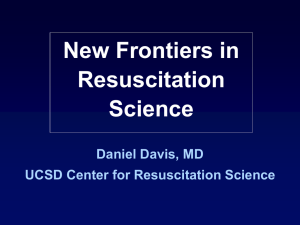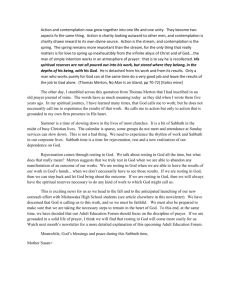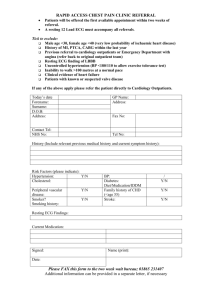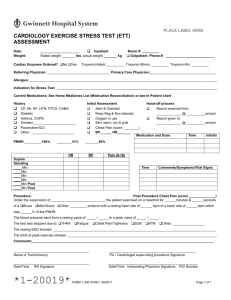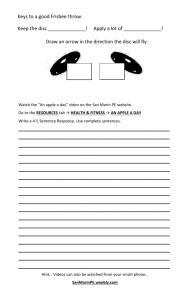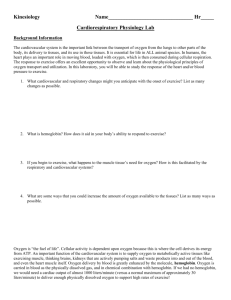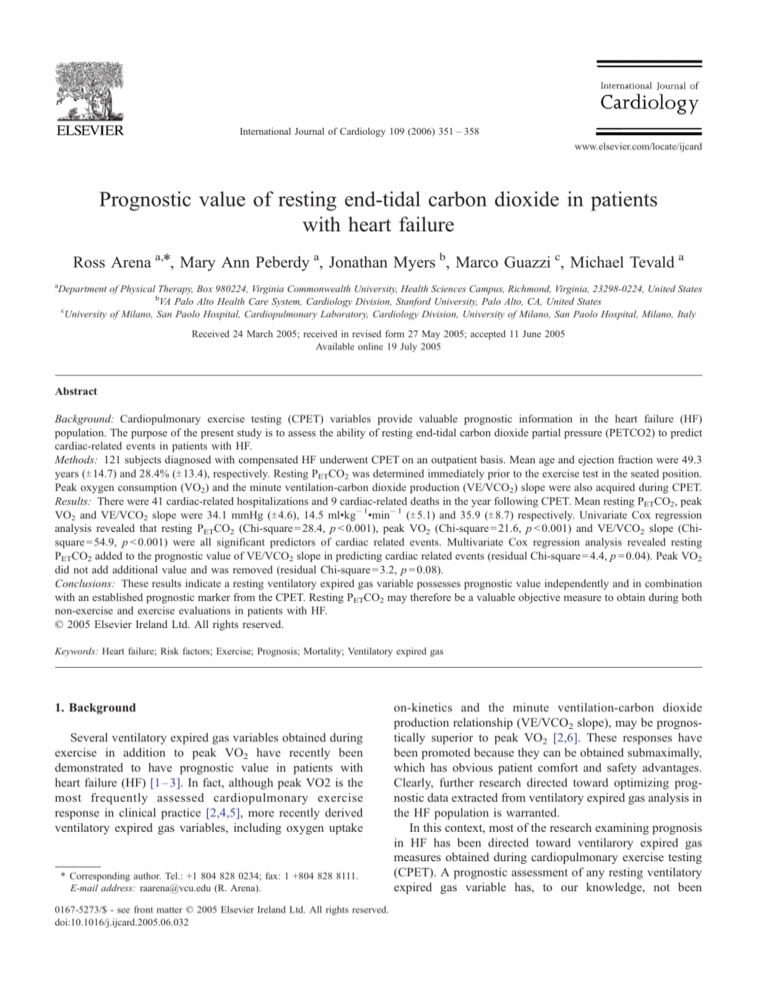
International Journal of Cardiology 109 (2006) 351 – 358
www.elsevier.com/locate/ijcard
Prognostic value of resting end-tidal carbon dioxide in patients
with heart failure
Ross Arena a,*, Mary Ann Peberdy a, Jonathan Myers b, Marco Guazzi c, Michael Tevald a
a
Department of Physical Therapy, Box 980224, Virginia Commonwealth University, Health Sciences Campus, Richmond, Virginia, 23298-0224, United States
b
VA Palo Alto Health Care System, Cardiology Division, Stanford University, Palo Alto, CA, United States
c
University of Milano, San Paolo Hospital, Cardiopulmonary Laboratory, Cardiology Division, University of Milano, San Paolo Hospital, Milano, Italy
Received 24 March 2005; received in revised form 27 May 2005; accepted 11 June 2005
Available online 19 July 2005
Abstract
Background: Cardiopulmonary exercise testing (CPET) variables provide valuable prognostic information in the heart failure (HF)
population. The purpose of the present study is to assess the ability of resting end-tidal carbon dioxide partial pressure (PETCO2) to predict
cardiac-related events in patients with HF.
Methods: 121 subjects diagnosed with compensated HF underwent CPET on an outpatient basis. Mean age and ejection fraction were 49.3
years (T 14.7) and 28.4% (T 13.4), respectively. Resting PETCO2 was determined immediately prior to the exercise test in the seated position.
Peak oxygen consumption (VO2) and the minute ventilation-carbon dioxide production (VE/VCO2) slope were also acquired during CPET.
Results: There were 41 cardiac-related hospitalizations and 9 cardiac-related deaths in the year following CPET. Mean resting PETCO2, peak
VO2 and VE/VCO2 slope were 34.1 mmHg (T4.6), 14.5 ml&kg 1&min 1 (T 5.1) and 35.9 (T 8.7) respectively. Univariate Cox regression
analysis revealed that resting PETCO2 (Chi-square = 28.4, p < 0.001), peak VO2 (Chi-square = 21.6, p < 0.001) and VE/VCO2 slope (Chisquare = 54.9, p < 0.001) were all significant predictors of cardiac related events. Multivariate Cox regression analysis revealed resting
PETCO2 added to the prognostic value of VE/VCO2 slope in predicting cardiac related events (residual Chi-square = 4.4, p = 0.04). Peak VO2
did not add additional value and was removed (residual Chi-square = 3.2, p = 0.08).
Conclusions: These results indicate a resting ventilatory expired gas variable possesses prognostic value independently and in combination
with an established prognostic marker from the CPET. Resting PETCO2 may therefore be a valuable objective measure to obtain during both
non-exercise and exercise evaluations in patients with HF.
D 2005 Elsevier Ireland Ltd. All rights reserved.
Keywords: Heart failure; Risk factors; Exercise; Prognosis; Mortality; Ventilatory expired gas
1. Background
Several ventilatory expired gas variables obtained during
exercise in addition to peak VO2 have recently been
demonstrated to have prognostic value in patients with
heart failure (HF) [1– 3]. In fact, although peak VO2 is the
most frequently assessed cardiopulmonary exercise
response in clinical practice [2,4,5], more recently derived
ventilatory expired gas variables, including oxygen uptake
* Corresponding author. Tel.: +1 804 828 0234; fax: 1 +804 828 8111.
E-mail address: raarena@vcu.edu (R. Arena).
0167-5273/$ - see front matter D 2005 Elsevier Ireland Ltd. All rights reserved.
doi:10.1016/j.ijcard.2005.06.032
on-kinetics and the minute ventilation-carbon dioxide
production relationship (VE/VCO2 slope), may be prognostically superior to peak VO2 [2,6]. These responses have
been promoted because they can be obtained submaximally,
which has obvious patient comfort and safety advantages.
Clearly, further research directed toward optimizing prognostic data extracted from ventilatory expired gas analysis in
the HF population is warranted.
In this context, most of the research examining prognosis
in HF has been directed toward ventilarory expired gas
measures obtained during cardiopulmonary exercise testing
(CPET). A prognostic assessment of any resting ventilatory
expired gas variable has, to our knowledge, not been
352
R. Arena et al. / International Journal of Cardiology 109 (2006) 351 – 358
conducted. The resting partial pressure of end-tidal carbon
dioxide (PETCO2) may have prognostic value in patients
with HF. Previous research has already demonstrated a
significant relationship between PETCO2 during exercise
and cardiac function in patients with HF [7,8]. Numerous
investigations have furthermore demonstrated a positive
relationship between resting PETCO2 and cardiac output [9–
14]. None of these latter studies involved HF patients per se
and data collection was largely conducted during intubation
and sedation. Translation of these results to an ambulatory
HF population is plausible, since a low cardiac output
equates to a low resting PETCO2. In making this assumption,
one can reasonably hypothesize a lower resting PETCO2
value in patients with HF would indicate poorer cardiac
function and therefore poorer prognosis. The purpose of the
present study was to therefore assess the ability of resting
PETCO2, independently and in combination with peak VO2,
VE/VCO2 slope and several other clinically relevant
variables, to predict cardiac-related events in a group of
patients diagnosed with HF.
2. Materials and methods
One hundred and twenty-one consecutive subjects
diagnosed with compensated HF underwent a symptomlimited CPET between 5/15/97 and 10/18/04 at Virginia
Commonwealth University Medical Center and retrospectively assessed for this study. All tests were conducted on an
outpatient basis and written informed consent was obtained
from all subjects prior to testing. Virginia Commonwealth
University Institutional Review Board approval was
obtained for those subjects undergoing an exercise test as
part of a prospective research project and not as a standard
of care. The CPET procedures were, however, identical for
all subjects. Subject and pharmacological characteristics are
listed in Table 1.
Exclusion criteria consisted of diagnosed pulmonary
disease (per physician examination and medical chart
review), myocardial infarction within the past six months,
signs and/or symptoms suggestive of decompensated HF,
and/or any orthopedic condition that would not allow the
subject to ambulate on a treadmill. Inclusion criteria
consisted of a previous diagnosis of HF that was in a
compensated state at the time of testing and evidence of left
ventricular dysfunction by echocardiogram.
2.1. Equipment calibration
Ventilatory expired gas analysis was obtained using a
metabolic cart (Medgraphics CPX-D, Minneapolis, MN or
Sensormedics Vmax29, Yorba Linda, CA). The oxygen and
carbon dioxide sensors were calibrated using gases with
known oxygen, nitrogen, and carbon dioxide concentrations
prior to each test. The flow sensor was also calibrated before
each test using a three-liter syringe.
2.2. Testing procedure and data collection
Resting PETCO2 was collected immediately prior to
exercise testing. Subjects were in the sitting position and
ventilating through the mouthpiece for at least 30 s before
collection of resting PETCO2 data began. Data collection
was not initiated until the individuals conducting the
exercise test observed a relaxed ventilatory pattern.
Previous work by our group has demonstrated resting
PETCO2 is highly reliable thereby supporting the use of a
single data collection session in the present investigation
(intraclass correlation coefficient = 0.93, standard error of
measurement with 95% confidence limits: T 2.1 mmHg)
[15].
Symptom-limited CPET was conducted using a treadmill. The modified ramping protocol selected for testing
consisted of approximately 2 mlO2&kg 1&min 1 increases
in workload every 30 s [5,16,17]. Stage 1 began at 1.0 mile
per hour (mph) and a 0% grade. Stages increased by 0.1
mph and 0.5% grade thereafter. The same conservative
treadmill protocol was used to test all subjects. Monitoring
consisted of continuous 12-lead electrocardiography (Quinton 4000, Seattle, WA), manual blood pressure measurements approximately every third stage (90 s), heart rate
recordings every stage via the electrocardiogram and rating
of perceived exertion (Borg 15 grade scale) each stage. Test
termination criteria consisted of patient request, ventricular
tachycardia, 2 mm of horizontal or downsloping ST
segment depression or a drop in systolic blood pressure
20 mm/Hg during progressive exercise. A qualified
exercise physiologist with physician supervision conducted
each exercise test.
2.3. Data analysis
Resting PETCO2 was defined as the two-minute
averaged value prior to exercise testing in the seated
position. Oxygen consumption (ml&kg 1&min 1), VCO2
(L/min), and VE (L/min) were collected throughout the
exercise test. Peak VO2 was expressed as the highest 10-s
average value obtained during the last 30-s stage of the
exercise test. The ventilatory equivalents method was used
to determine oxygen consumption at ventilatory threshold
(VT) [18]. Resting and peak oxygen pulse was determined
by dividing the ten second averaged value of oxygen
uptake (ml/min) by the ten second averaged value of heart
rate at peak exercise. The ventilatory dead space to tidal
volume ratio (VD/VT) was also estimated at rest and
maximal exercise. Ten second averaged VE and VCO2
data, from the initiation of exercise to peak, were input
into spreadsheet software (Microsoft Excel, Microsoft
Corp., Bellevue, WA) to calculate the VE/VCO2 slope
via least squares linear regression ( y = mx + b, m = slope).
Previous work by our group has shown this calculation
method of VE/VCO2 slope to be prognostically optimal
[19].
R. Arena et al. / International Journal of Cardiology 109 (2006) 351 – 358
353
2.4. Endpoints
Table 2
Key ventilatory expired gas variables
Subjects were followed for cardiac-related mortality and
hospitalization for one-year following exercise testing via
medical chart review. Cardiac-related mortality was defined
as death directly resulting from failure of the cardiac system.
An example fitting this definition is sudden cardiac death.
Cardiac-related hospitalization was defined as a hospital
admission directly resulting from cardiac dysfunction
requiring in-patient care to correct. An example fitting this
definition is decompensated HF requiring intravenous
inotropic and diuretic support. Any death or hospital
admission with a cardiac-related discharge diagnosis, confirmed by diagnostic tests or autopsy, was considered an
event. The most common causes of mortality, as per
discharge diagnosis, were sudden cardiac death, myocardial
infarction, and HF. The most common causes of hospitalization were decompensated HF and coronary artery
disease. Subjects in whom mortality was of a non-cardiac
etiology were treated as censored cases. All subjects were
followed as outpatients by Virginia Commonwealth University Medical Center. The subjects requiring hospitalization were most frequently received their care at Virginia
Commonwealth University Medical Center. In the rare event
subjects were hospitalized at another institution for emergent care, a discharge note was sent to Virginia Commonwealth University Medical Center and maintained in the
patients chart. We are highly confident all events were
captured for this sample.
Variable
Mean T Standard Deviation
Resting PETCO2 (mmHg)
Peak VO2 (ml&kg 1&min 1)
VO2 at VT (ml&kg 1&min 1)
VE/VCO2 Slope
Peak RER
Resting oxygen pulse (ml/beat)
Peak oxygen pulse (ml/beat)
Resting VD/VT
Peak VD/VT
34.1 T 4.6
14.5 T 5.1
11.6 T 3.9
35.9 T 8.7
1.05 T 0.1
4.0 T 1.5
10.1 T 4.0
0.37 T 0.07
0.25 T 0.07
2.5. Statistical analysis
The mean and standard deviation were reported for key
variables. Pearson product moment correlation was used to
assess the relationship between resting PETCO2 and key
baseline and exercise variables. Univariate Cox regression
analysis was used to determine the ability of body mass
index (BMI), left ventricular ejection fraction (LVEF), betablockade use, New York Heart Association (NYHA) Class,
3. Results
None of the CPETs were terminated prematurely
secondary to signs/symptoms of ischemia, arrhythmias or
Table 1
Subject characteristics
Number of subjects
Age (years)
Body mass index (kg/m2)
Left ventricular ejection fraction (%)U
New York Heart Association Class
(number of subjects)
Class I
Class II
Class III
Heart failure etiology (ischemic/non-ischemic)
ACE inhibitor (number of subjects)
Cardiac glycoside (number of subjects)
Diuretic (number of subjects)
Nitrate (number of subjects)
Beta-blocker (number of subjects)
resting PETCO2, peak VO2 and VE/VCO2 slope to predict
cardiac-related events over the one-year tracking period.
Multivariate Cox regression analysis (forward stepwise
method) was used to assess the combined ability of the
variables found to be prognostically significant in the
univariate analysis (NYHA Class, resting PETCO2, peak
VO2 and VE/VCO2 slope) to also predict one year cardiacrelated events. Entry and removal p-values were set at 0.05
and 0.10 respectively. Receiver operating characteristic
(ROC) curve analysis assessed the classification scheme
and determined the optimal threshold value of ventilatory
expired gas variables retained in the multivariate Cox
regression analysis. Univariate Cox regression analysis was
again used to determine the hazard ratio of optimal threshold
values as determined by ROC curve analysis. Kaplan –Meier
analysis examined event-free survival characteristics of
subjects based upon the optimal threshold value of resting
PETCO2 and VE/VCO2 slope, independently. Kaplan –Meier
analysis was also used to assess the event-free survival
characteristics of subjects based on the combined optimal
threshold values of resting PETCO2 and VE/VCO2 slope. A
statistical software program was used for all data analysis
(SPSS 12.0 for Windows, Chicago, IL). All statistical tests
with a p-value <0.05 were considered significant.
121 (76 male/45 female)
49.3 T 14.7
28.7 (T6.8)
28.4% T 13.4
Table 3
Pearson product moment correlation between resting PETCO2 and key
variables
22
35
64
51/70
92
90
100
29
59
Age
Left ventricular ejection fraction
Body mass index
VE/VCO2 slope
Peak VO2
Resting oxygen pulse
Peak oxygen pulse
Resting VD/VT
Peak VD/VT
Resting PETCO2
U: Determined by two-dimensional echocardiography.
* p < 0.001.
0.10
0.13
0.34*
0.62*
0.32*
0.39*
0.36*
0.30*
0.35*
354
R. Arena et al. / International Journal of Cardiology 109 (2006) 351 – 358
1.0
Table 4
Univariate and multivariate Cox Regression Analysis for one-year cardiacrelated events
Chi-square
p-value
Univariate analysis
Body mass index
Left ventricular ejection fraction
Beta-blockade use
New York Heart Association Class
Resting PETCO2
VE/VCO2 slope
Peak VO2
0.82
3.7
0.44
17.6
28.4
54.9
21.6
0.37
0.06
0.51
<0.001*
<0.001*
<0.001*
<0.001*
0.8
Sensitivity
Predictor variable
0.6
0.4
0.2
0.0
Multivariate analysis
VE/VCO2 slope
Resting PETCO2
New York Heart Association Class
Peak VO2
54.9
4.4
4.4
0.07
<0.001*
0.04*
0.04*
0.80
* Statistically significant.
hemodymanic abnormalities (excessive hypo/hypertension).
There were 41 cardiac-related hospitalizations and 9
cardiac-related deaths in the year following CPET. Heart
rate at rest and maximal exercise were 80.4 (T 16.0) and
124.4 (T25.2) beats per minute respectively. Key ventilatory
expired gas variables are listed in Table 2.
Based on individual peak VO2 values, Weber classification for the group was as follows; Weber class A: 17, Weber
class B: 25, Weber class C: 57, Weber class D: 22. Sixty-six
percent of the subjects in the present study achieved a peak
RER 1.0. Pearson product correlation results are listed in
Table 3. Resting PETCO2 was not significantly correlated
with age or LVEF. The relationship between resting PETCO2
and peak VO2, VE/VCO2 slope, oxygen pulse, VD/VT, and
BMI were statistically significant.
Univariate and Multivariate Cox regression analysis
results are listed in Table 4. Univariate Cox regression
analysis revealed NYHA class, resting PETCO2, peak VO2
1.0
Sensitivity
0.8
0.6
0.4
0.2
0.0
0.0
0.2
0.4
0.6
0.8
0.0
0.2
0.4
0.6
0.8
1.0
1 - Specificity
Fig. 2. Receiver operating characteristic curve analysis for one-year cardiac
related events: VE/VCO2 slope
Variable
Area under
the curve
95% Confidence
interval
p-value
VE/VCO2 slope
0.84
0.76 – 0.92
p < 0.001
and VE/VCO2 slope were all significant predictors of
cardiac-related events. Body mass index, LVEF and betablockade use were not significant predictors of outcome in
the univariate Cox regression analysis. Multivariate Cox
regression analysis revealed NYHA class and resting
PETCO2 added to the prognostic value to VE/VCO2 slope
in predicting one year cardiac-related events. Peak VO2 did
not add additional value and was removed from the
multivariate regression.
Receiver operating characteristic curves for resting
PETCO2 and VE/VCO2 slope as continuous variables are
illustrated in Figs. 1 and 2, respectively.
Optimal threshold values for resting PETCO2 (greater
value preferred) and VE/VCO2 slope (lesser value preferred)
were /> 33.0 mmHg (ROC area = 0.74, p < 0.001, sensitivity = 75%, Specificity = 72%) and </ 34.4 (ROC area=0.84,
p < 0.001, sensitivity = 78%, Specificity = 82%), respectively.
Univariate hazard ratios for resting PETCO2 and VE/VCO2
slope threshold values are listed in Table 5.
Kaplan Meier analyses using the predetermined threshold
values of resting PETCO2 alone, VE/VCO2 slope alone and
resting PET CO2 combined with VE/VCO2 slope are
illustrated in Figs. 3 –5.
Using the optimal resting PETCO2 threshold value as
determined by ROC curve analysis, sixty-seven subjects
Table 5
Univariate hazard ratios for resting PETCO2 (greater value preferred) and
VE/VCO2 slope (lesser value preferred) threshold values
1.0
1 - Specificity
Fig. 1. Receiver operating characteristic curve analysis for one-year cardiac
related events: resting PETCO2
Variable
Area under
the curve
95% Confidence
interval
p-value
Resting PETCO2
0.74
0.63 – 0.84
p < 0.001
End point
Threshold criteria
Hazard
ratio
p-value
Cardiac-related
Events (1 yr)
Cardiac-related
Events (1 yr)
Resting PETCO2 33.0 = negative
prognosis
VE/VCO2 slope 34.4 = negative
prognosis
4.8
<0.0001
7.2
<0.0001
1.0
1.0
0.8
0.8
A
0.6
0.4
B
0.2
0.0
0.6
B
0.4
0.2
C
0.0
0.00
2.00
4.00
6.00
8.00 10.00 12.00
0.00
Months
A
B
Characteristics
Resting PETCO2 > 33.0 mmHg
Resting PETCO2 33.0 mmHg
Subjects
meeting
criteria
Events
67
54
14.
36U
Percent
event
free
79.1%
33.3%
Log rank = 31.0, p < 0.0001. & = Censored cases. . = 2 cardiac-related deaths
and 12 cardiac- related hospitalizations. U = 7 cardiac-related deaths and 29
cardiac-related hospitalizations.
demonstrated a favorable resting PETCO2 value while the
remaining fifty-four possessed an unfavorable value. The
percentage of subjects who were event-free for the one-year
tracking period with a favorable value and unfavorable
resting PETCO2 value was 79.1% and 33.3% respectively.
Using the optimal VE/VCO2 slope threshold value as
determined by ROC curve analysis, sixty-two subjects
Event-Free Survival
1.0
A
0.8
0.6
0.4
B
0.2
0.0
2.00
4.00
6.00
4.00
6.00
8.00 10.00 12.00
Fig. 5. Kaplan-Meier analysis for one-year cardiac-related events using
resting PETCO2 threshold of /> 33.0 mmHg and VE/VCO2 slope
threshold of </ 34.4.Legend for Fig. 5
Group Characteristics
Subjects Events Percent
meeting
event
criteria
free
A
48
4.
91.7%
33
15U
54.5%
40
31
22.5%
B
C
0.00
2.00
Months
Fig. 3. Kaplan – Meier analysis for one-year cardiac-related events using a
resting PETCO2 threshold of /> 33.0 mmHg.Legend for Fig. 3
Group
355
A
Event-Free Survival
Event-Free Survival
R. Arena et al. / International Journal of Cardiology 109 (2006) 351 – 358
Resting PETCO2 > 33.0 mmHg and
VE/VCO2 slope < 34.4
Resting PETCO2 = 33.0 mmHg or
VE/VCO2 slope 34.4
Resting PETCO2 33.0 mmHg and
VE/VCO2 slope 34.4
Log rank = 50.9, p < 0.0001. & = censored cases. . = 0 cardiac-related deaths
and 4 cardiac-related Hospitalizations. U = 2 cardiac-related deaths and 13
cardiac-related hospitalizations. = 7 cardiac-related deaths and 24 cardiac
related hospitalizations.
demonstrated a favorable VE/VCO2 slope value while the
remaining fifty-nine possessed an unfavorable value. The
percentage of subjects who were event-free for the one-year
tracking period with a favorable value and unfavorable VE/
VCO2 slope value was 85.5% and 30.5% respectively.
When combining resting PETCO2 with VE/VCO2 slope,
forty-eight subjects demonstrated favorable values for both
variables, thirty-three subjects demonstrated one unfavorable value (resting PETCO2 or VE/VCO2 slope) and forty
subjects demonstrated unfavorable values for both variables.
The number of subjects who were event-free for the oneyear tracking period with no unfavorable values, one
unfavorable value and two unfavorable values were
91.7.1%, 54.5% and 22.2% respectively.
8.00 10.00 12.00
Months
4. Discussion
Fig. 4. Kaplan-Meier analysis for one-year cardiac-related events using a
VE/VCO2 slope threshold of </ 34.4 mmHg.Legend for Fig. 4
Group
Characteristics
Subjects
meeting
criteria
Events
Percent
event
free
A
B
VE/VCO2 slope < 34.3
VE/VCO2 slope 34.3
62
59
9.
41U
85.5%
30.5%
Log rank = .6, p < 0.0001. & = Censored cases. . = 0 cardiac-related deaths
and 9 cardiac-related hospitalizations. U = 9 cardiac-related deaths and 32
cardiac related hospitalizations
The results of the present study indicate that resting
PETCO2 is significantly correlated with CPET variables
previously shown to have diagnostic and/or prognostic
value in HF. There does not appear to be a clinically
significant relationship between resting PETCO2 and either
age or LVEF. A significant positive correlation between
resting PETCO2 and BMI was, however, apparent. This
relationship indicates individuals with a higher BMI tended
to have a more favorable resting PETCO2 value. This latter
356
R. Arena et al. / International Journal of Cardiology 109 (2006) 351 – 358
finding is consistent with previous investigations reporting
improved prognosis with increased BMI in patients with
HF [20]. More importantly from a clinical perspective,
resting PETCO2 appears to be a significant predictor of
cardiac-related events both independently and in combination with an established clinical (NYHA class) and
ventilatory expired gas (VE/VCO2 slope) variable. Acquisition of resting PETCO2 may therefore be warranted during
both resting and exercise clinical evaluations in patients
with HF.
A significant relationship between resting PETCO2 and
cardiac output has been demonstrated in a number of
previous investigations in subjects not diagnosed with HF.
In a group of patients undergoing abdominal aortic
aneurysm repair, Shibutani et al. [21] found PETCO2 was
significantly correlated with changes in cardiac output
during surgery (R2 = 0.82, p < 0.01). Wahba et al. [14] found
PETCO2, taken before and after elective open-heart surgery,
was strongly related to changes in cardiac index (r = 0.75,
p < 0.001). In an intubated/sedated model, findings from
Idris et al. [11] suggested PETCO2 was able to accurately
reflect cardiac output over a wide range of flow rates,
including very low flow rates. In 23 subjects who were in
cardiac arrest, Garnett et al. [22] reported an immediate and
significant increase in PETCO2 in the 10 subjects who
experienced a return in spontaneous circulation. Lastly,
Asplin et al. [23] found that higher initial PETCO2 values
predicted the return of spontaneous circulation in 27 patients
suffering cardiac arrest. These previous investigations
provided our impetus to hypothesize that resting PETCO2
would be a significant predictor of cardiac-related events in
patients with HF secondary to it_s reflection of cardiac
function. In the present study, a significant positive
correlation between resting PETCO2 and oxygen pulse at
rest and peak exercise, a non-invasive indicator or cardiac
function, was found. A significant negative correlation
between resting PETCO2 and VD/VT at rest and peak
exercise, a non-invasive indicator of ventilation –perfusion
matching, was also found. This latter finding may also be
attributed to the link between cardiac function and
pulmonary perfusion. Previous research has already demonstrated a significant relationship between PETCO2 during
exercise and cardiac function in subjects with HF [7,8]. The
results of the present study provide initial evidence that
there is also a relationship between PETCO2 and cardiac
function at rest in subjects with HF. Additional research is,
however, required to more thoroughly examine the association between resting PETCO2 and cardiac function in the
HF population.
Patients diagnosed with HF frequently attend outpatient
clinics at regular intervals to assess the stability of their
condition and alter medical management as indicated. A
number of resting measures, including NYHA class,
echocardiography [3,24 – 26], ECG [26 – 30], blood pressure [31 –33] and inflammatory [34 – 37] and neurohormonal blood markers, [38,39] have been shown to provide
information pertinent to prognosis and disease severity and
are therefore frequently ascertained during clinic visits.
The current results suggest consideration should be given
to adding resting PETCO2 to the list of measures
incorporated into the non-exercise assessment of HF. The
non-invasive nature by which resting PETCO2 can be
rapidly assessed makes this a promising clinical measure,
particularly in rural medical settings where assessment
techniques may be limited. Future research should be
directed toward comparing the prognostic power of resting
PETCO2 to a more comprehensive list of clinically
established resting measures.
Cardiopulmonary exercise testing is considered a standard of care in the HF population and is therefore frequently
employed to assess HF severity and assist in determining
appropriateness for transplant candidacy.[40,41] Although
the focus of CPET in HF has been on peak VO2, a number
of recent investigations have challenged its prognostic
power relative to other CPET variables, particularly the
VE/VCO2 slope [3 –6,42 – 44]. The results of the present
study are consistent with these recent investigations in that
the VE/VCO2 slope had greater prognostic power than peak
VO2. Peak VO2 has two potential limitations when
assessing prognosis. First, a true assessment of peak VO2
is dependent on subject effort. Even with the most diligent
efforts by clinicians to illicit maximal effort, a percentage of
HF patients will voluntarily terminate the exercise test
prematurely. This was readily apparent in the present study
as 34% of our subjects failed to attain a peak RER 1.0. A
second potential limitation is the contribution peripheral
metabolism has on peak VO2. This contribution is made
apparent by investigations demonstrating that high values
for peak VO2 are paralleled by superior skeletal muscle
metabolic capacity [45]. Although studies citing superior
peripheral metabolic function attribute this phenomenon to
exercise training, one should not expect those patients with
HF who are similarly sedentary or trained to have
homogeneous muscle fiber characteristics [46]. Thus, two
HF patients with similar cardiac but differing skeletal
muscle function, who both put forth a maximal effort
during exercise, may have different values for peak VO2.
This issue was raised by the work of Wilson et al. [47] who
reported that among 64 patients evaluated for heart transplantation, cardiac output and pulmonary wedge pressure
responses to exercise differed markedly despite patients
having similar values for peak VO2. These results additionally indicate that resting PETCO2 may add prognostic value
when assessed in combination with the VE/VCO2 slope in
estimating risk in HF, a finding that has not been previously
reported. Both resting PETCO2 and the VE/VCO2 slope are
not influenced by subject effort, which may be a primary
reason for their superior prognostic value compared to peak
VO2. As this type of evidence continues to mount,
consideration should be given to revising established
guidelines, which presently recommend only the assessment
of peak VO2 for risk stratification in HF [40,41]. Specifi-
R. Arena et al. / International Journal of Cardiology 109 (2006) 351 – 358
cally, the VE/VCO2 slope appears to be the superior
prognostic CPET variable. If future research supports our
findings, the inclusion of resting PETCO2 when applying
CPET results in HF may also be warranted.
Individuals with HF can shift from a stable to an
uncompensated status (or vice versa) rather abruptly.
Limiting the post-CPET tracking period to one-year may
be clinically optimal given the fluid nature of cardiac
function in the HF patient. We recently completed an
analysis of the impact of time past CPET on the prognostic
characteristics of VE/VCO2 slope and peak VO2 in subjects
with HF [48]. This analysis indicated prognostic sensitivity
modestly rose while specificity dramatically fell for both
CPET variables greater than one-year post exercise testing.
A one-year tracking period may therefore strike a sufficient
balance between avoiding outdated information and the
economic constraints of multiple exercise tests.
Additionally, most research examining the prognostic
value of CPET data do not use hospitalization as an
endpoint. Given that HF is the primary hospital diagnostic
related group among Medicare patients [49], analysis of
measures predicting hospitalization in this population seems
warranted. The ability of the VE/VCO2 slope and resting
PETCO2 to effectively predict hospitalization may help
identify high-risk patients and provide appropriate interventions on an outpatient basis thereby preventing nonfatal
adverse events (hospitalization) and reduce health care
costs.
The relatively small sample size in the present investigation must be considered a limitation. Furthermore, a
number of subjects in the present study were not prescribed
a beta-blocking agent at the time of CPET. Several recent
investigations have demonstrated peak VO2 remains prognostically significant in patients with CHF receiving a betablocking agent [50,51]. The prognostic impact of betablockade use on other CPET variables, however, has not
been investigated thoroughly. Additional research assessing
the association between resting PETCO2, cardiac function
and outcomes, as well as the impact of beta-blockade use, is
needed before a universal recommendation for including
resting PETCO2 in the clinical assessment of patients with
HF can be made.
5. Conclusions
In conclusion, ventilatory expired gas analysis during
exercise continues to demonstrate clinical value in patients
with HF. Variables ascertained from this analysis have
traditionally been collected during exercise testing. The
results of the present study indicate the value of ventilatory
expired gas analysis may extend past that which is gained
during physical exertion. Efforts should be directed toward
maximizing the information gained from this non-invasive
assessment technique and promoting the implementation of
recent research findings into clinical practice.
357
References
[1] Koike A, Koyama Y, Itoh H, Adachi H, Marumo F, Hiroe M.
Prognostic significance of cardiopulmonary exercise testing for 10year survival in patients with mild to moderate heart failure. Jpn Circ J
2000;64(12):915 – 20.
[2] Brunner-La Rocca HP, Weilenmann D, Schalcher C, et al. Prognostic
significance of oxygen uptake kinetics during low level exercise in
patients with heart failure. Am J Cardiol 1999;84(6):741 – 4 [A9].
[3] Francis DP, Shamim W, Davies LC, et al. Cardiopulmonary exercise
testing for prognosis in chronic heart failure: continuous and
independent prognostic value from VE/VCO(2)slope and peak
VO(2). Eur Heart J 2000;21(2):154 – 61.
[4] Robbins M, Francis G, Pashkow FJ, et al. Ventilatory and heart rate
responses to exercise: better predictors of heart failure mortality than
peak oxygen consumption. Circulation 1999;100(24):2411 – 7.
[5] Arena R, Humphrey R. Comparison of ventilatory expired gas
parameters used to predict hospitalization in patients with heart
failure. Am Heart J 2002;143(3):427 – 32.
[6] Arena R, Myers J, Aslam SS, Varughese EB, Peberdy MA. Peak VO2
and VE/VCO2 slope in patients with heart failure: a prognostic
comparison. Am Heart J 2004;147(2):354 – 60.
[7] Matsumoto A, Itoh H, Eto Y, et al. End-tidal CO2 pressure decreases
during exercise in cardiac patients: association with severity of heart
failure and cardiac output reserve. J Am Coll Cardiol 2000;36(1):
242 – 9.
[8] Tanabe Y, Hosaka Y, Ito M, Ito E, Suzuki K. Significance of end-tidal
P(CO(2)) response to exercise and its relation to functional capacity in
patients with chronic heart failure. Chest 2001;119(3):811 – 7.
[9] Jin X, Weil MH, Tang W, et al. End-tidal carbon dioxide as a
noninvasive indicator of cardiac index during circulatory shock. Crit
Care Med 2000;28(7):2415 – 9.
[10] Isserles SA, Breen PH. Can changes in end-tidal PCO2 measure
changes in cardiac output? Anesth Analg 1991;73(6):808 – 14.
[11] Idris AH, Staples ED, O’Brien DJ, et al. End-tidal carbon dioxide
during extremely low cardiac output. Ann Emerg Med 1994;23(3):
568 – 72.
[12] Hayashida M, Orii R, Komatsu K, et al. [Effects of cardiac output on
PETCO2 and PaCO2 during combined inhalational-epidural anesthesia].
Masui 1997;46(10):1290 – 8.
[13] Hayashida M, Orii R, Komatsu K, et al. [Relationship between cardiac
output and PETco2 as well as Paco2 during high-dose fentanyl
anesthesia]. Masui 1998;47(2):161 – 7.
[14] Wahba RW, Tessler MJ, Beique F, Kleiman SJ. Changes in PCO2 with
acute changes in cardiac index. Can J Anaesth 1996;43(3):243 – 5.
[15] Arena R, Peberdy MA. Reliability of resting end-tidal carbon dioxide
in chronic heart failure. J Cardiopulm Rehabil 2005;25(3):177 – 80.
[16] McInnis KJ, Bader DS, Pierce GL, Balady GJ. Comparison of
cardiopulmonary responses in obese women using ramp versus step
treadmill protocols. Am J Cardiol 1999;83(2):289 – 91 [A7].
[17] Arena R, Humphrey R. Relationship between ventilatory expired
gas and cardiac parameters during symptom-limited exercise testing
in patients with heart failure. J Cardiopulm Rehabil 2001;21(3):
130 – 4.
[18] Fletcher GF, Balady GJ, Amsterdam EA, et al. Exercise standards for
testing and training: a statement for healthcare professionals from the
American Heart Association. Circulation 2001;104(14):1694 – 740.
[19] Arena R, Myers J, Aslam S, Varughese EB, Peberdy MA. Technical
considerations related to the minute ventilation/carbon dioxide output
slope in patients with heart failure. Chest 2003;124(2):720 – 7.
[20] Gustafsson F, Kragelund CB, Torp-Pedersen C, et al. Effect of obesity
and being overweight on long-term mortality in congestive heart
failure: influence of left ventricular systolic function. Eur Heart J
2005;26(1):58 – 64.
[21] Shibutani K, Muraoka M, Shirasaki S, Kubal K, Sanchala VT, Gupte
P. Do changes in end-tidal PCO2 quantitatively reflect changes in
cardiac output? Anesth Analg 1994;79(5):829 – 33.
358
R. Arena et al. / International Journal of Cardiology 109 (2006) 351 – 358
[22] Garnett AR, Ornato JP, Gonzalez ER, Johnson EB. End-tidal carbon
dioxide monitoring during cardiopulmonary resuscitation. JAMA
1987;257(4):512 – 5.
[23] Asplin(*) B, White R. Prognostic value of end-tidal carbon dioxide
pressures during out-of-hospital cardiac arrest. Ann Emerg Med 1995;
25(6):756 – 61.
[24] Kerzner R, Gage BF, Freedland KE, Rich MW. Predictors of
mortality in younger and older patients with heart failure and
preserved or reduced left ventricular ejection fraction*1. Am Heart
J 2003;146(2):286 – 90.
[25] Davos CH, Doehner W, Rauchhaus M, et al. Body mass and survival
in patients with chronic heart failure without cachexia: the importance
of obesity. J Card Fail 2003;9(1):29 – 35.
[26] Fappani A, Caprini L, Benedini G, Maggi A, Raddino R, Visioli O.
[The prognosis of the patient with heart failure: an analysis of the most
significant clinical and instrumental parameters]. Cardiologia
1991;36(6):431 – 8.
[27] Tomkiewicz-Pajak L, Podolec P, Kostkiewicz M, Tracz W, Suchon E,
Krochin M. [Prognostic value of results from clinical tests, echocardiographic, electrocardiographic and spiro-ergometric exercise test
examinations in patients with heart failure]. Przegl Lek 2002;59(8):
572 – 6.
[28] Vrtovec B, Delgado R, Zewail A, Thomas CD, Richartz BM,
Radovancevic B. Prolonged QTc interval and high B-type natriuretic
peptide levels together predict mortality in patients with advanced
heart failure. Circulation 2003;107(13):1764 – 9.
[29] Grigioni F, Barbieri A, Magnani G, et al. Serial versus isolated
assessment of clinical and instrumental parameters in heart failure:
prognostic and therapeutic implications. Am Heart J 2003;146(2):
298 – 303.
[30] Baldasseroni S, Gentile A, Gorini M, et al. Intraventricular conduction
defects in patients with congestive heart failure: left but not right
bundle branch block is an independent predictor of prognosis. A report
from the Italian Network on Congestive Heart Failure (IN-CHF
database). Ital Heart J 2003;4(9):607 – 13.
[31] Lee DS, Austin PC, Rouleau JL, Liu PP, Naimark D, Tu JV.
Predicting mortality among patients hospitalized for heart failure:
derivation and validation of a clinical model. JAMA 2003;290(19):
2581 – 7.
[32] Cowie MR, Wood DA, Coats AJ, et al. Survival of patients with a new
diagnosis of heart failure: a population based study. Heart 2000;83(5):
505 – 10.
[33] Felker GM, Adams Jr KF, Konstam MA, O’Connor CM, Gheorghiade
M. The problem of decompensated heart failure: nomenclature,
classification, and risk stratification. Am Heart J 2003;145(2 Suppl):
S18 – 25.
[34] Kaneko K, Kanda T, Yamauchi Y, et al. C-reactive protein in dilated
cardiomyopathy. Cardiology 1999;91(4):215 – 9.
[35] Yin WH, Chen JW, Jen HL, et al. Independent prognostic value of
elevated high-sensitivity C-reactive protein in chronic heart failure.
Am Heart J 2004;147(5):931 – 8.
[36] Hayashidani S, Tsutsui H, Shiomi T, et al. Anti-monocyte chemoattractant protein-1 gene therapy attenuates left ventricular remodel-
[37]
[38]
[39]
[40]
[41]
[42]
[43]
[44]
[45]
[46]
[47]
[48]
[49]
[50]
[51]
ing and failure after experimental myocardial infarction. Circulation
2003;108(17):2134 – 40.
Behr TM, Wang X, Aiyar N, et al. Monocyte chemoattractant protein1 is upregulated in rats with volume-overload congestive heart failure.
Circulation 2000;102(11):1315 – 22.
Troughton RW, Prior DL, Pereira JJ, et al. Plasma B-type natriuretic
peptide levels in systolic heart failure: importance of left ventricular
diastolic function and right ventricular systolic function. J Am Coll
Cardiol 2004;43(3):416 – 22.
Latini R, Masson S, Anand I, et al. The comparative prognostic value
of plasma neurohormones at baseline in patients with heart failure
enrolled in Val-HeFT. Eur Heart J 2004;25(4):292 – 9.
Gibbons RJ, Balady GJ, Beasley JW, et al. ACC/AHA guidelines for
exercise testing. A report of the American College of cardiology/
American heart association task force on practice guidelines (committee on exercise testing). J Am Coll Cardiol 1997;30(1):260 – 311.
Gibbons RJ, Balady GJ, Timothy BJ, et al. ACC/AHA 2002 guideline
update for exercise testing: summary article. A report of the American
College of Cardiology/American Heart association task force on
practice guidelines (committee to update the 1997 exercise testing
guidelines). J Am Coll Cardiol 2002;40(8):1531 – 40.
MacGowan GA, Panzak G, Murali S. Exercise-related ventilatory
abnormalities are more specific for functional impairment in chronic
heart failure than reduction in peak exercise oxygen consumption. J
Heart Lung Transplant 2001;20(11):1167 – 73.
MacGowan GA, Murali S. Ventilatory and heart rate responses to
exercise: better predictors of heart failure mortality than peak exercise
oxygen consumption. Circulation 2000;102(24):E182.
Corra U, Mezzani A, Bosimini E, Scapellato F, Imparato A, Giannuzzi
P. Ventilatory response to exercise improves risk stratification in
patients with chronic heart failure and intermediate functional
capacity. Am Heart J 2002;143(3):418 – 26.
Sullivan MJ, Higginbotham MB, Cobb FR. Exercise training in
patients with severe left ventricular dysfunction. Hemodynamic and
metabolic effects. Circulation 1988;78(3):506 – 15.
Belardinelli R, Georgiou D, Scocco V, Barstow TJ, Purcaro A. Low
intensity exercise training in patients with chronic heart failure. J Am
Coll Cardiol 1995;26(4):975 – 82.
Wilson JR, Rayos G, Yeoh TK, Gothard P. Dissociation between peak
exercise oxygen consumption and hemodynamic dysfunction in
potential heart transplant candidates [see comments]. J Am Coll
Cardiol 1995;26(2):429 – 35.
Myers J, Arena R, Guazzi M. Impact of time past exercise testing on
prognostic variables in patients with heart failure. Eur J Cardiovasc
Prev Rehabil 2004;11:67 [Suppl].
Parmley WW. Heart failure awareness week: February 14 – 21. J Am
Coll Cardiol 2000;35(2):534.
O’Neill JO, Young JB, Pothier CE, Lauer MS. Peak oxygen
consumption as a predictor of death in patients with heart failure
receiving {beta}-blockers. Circulation 2005;111(18):2313 – 8.
Peterson LR, Schechtman KB, Ewald GA, et al. Timing of cardiac
transplantation in patients with heart failure receiving [beta]-adrenergic blockers*1. J Heart Lung Transplant 2003;22(10):1141 – 8.


